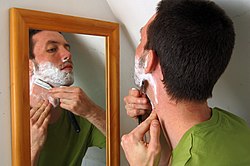Shaving cream
Shaving cream , also known as foaming shaving cream , usually consists of a pure potassium soap or a mixture of potassium and triethanolamine soaps. The typical pearlescent luster is caused by a content of free stearic acid . Often a superfatting agent - vaseline , wool wax, etc. - is also included, as well as water-binding (ie moisture-retaining) substances such as B. glycerin or sorbitol . Also fragrances are a common component of the recipe.
Non-foaming shaving cream
Non-foaming shaving creams are in front of the shaving applied to the previously washed skin, soaping with a shaving brush thus falls away. The shaving cream prevents the hair from drying out and facilitates the sliding movement of the razor on the skin. This type of shave is preferred by people with dry, low-fat skin, as it is easier on the skin than a lather shave. Non-foaming shaving creams chemically consist of over-greased stearate creams with emulsifiers , such as. B. triethanolamine , nonionic surfactants , lubricants ( paraffin oil , petrolatum , wool wax, etc.), humectants (glycerine, sorbitol, etc.) and other auxiliaries ( alginates , methyl cellulose, etc.) and preservatives . Important manufacturers are, for example, Proraso, Speick, Taylor of Old Bond Street and Musgo Real.
Aerosol shaving cream
Aerosol shaving creams, also shaving sprays or shaving foams, have a similar chemical composition to foaming or non-foaming shaving cream. They are injected onto the hand using a propellant (usually propane - butane ) from an aerosol can and distributed over the areas of skin to be shaved using circular movements. The use of shaving sprays is particularly convenient for the consumer and has largely replaced the use of shaving soap and foaming and non-foaming shaving creams for wet shaving .
Individual evidence
- ^ A b c Günter Vollmer and Manfred Franz: Chemical products in everyday life , Georg Thieme Verlag Stuttgart, 1985, pp. 150–151, ISBN 3-13-670201-8 .
- ↑ Otto-Albrecht Neumüller (Ed.): Römpps Chemie-Lexikon. Volume 5: Pl-S. 8th revised and expanded edition. Franckh'sche Verlagshandlung, Stuttgart 1987, ISBN 3-440-04515-3 , pp. 3495-3496.
